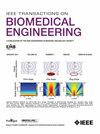Camera Seismocardiogram Based Monitoring of Left Ventricular Ejection Time
IF 4.5
2区 医学
Q2 ENGINEERING, BIOMEDICAL
引用次数: 0
Abstract
Left Ventricular Ejection Time (LVET), reflecting the duration from the onset to the end of blood ejection by the left ventricle during each heartbeat, is a critical parameter for measuring cardiac pumping efficiency. Continuous and regular monitoring of LVET is particularly crucial in assessing cardiac health, valvular function, and myocardial contractility. Seismocardiogram (SCG) signals can be utilized for LVET monitoring, as the temporal distance between the aortic valve opening (AO) and aortic valve closure (AC) in SCG signals can accurately depict LVET. This study proposes a novel way to extract LVET from laser speckle videos recorded by a remote camera based on the principle of defocused speckle imaging, thereby enabling non-contact monitoring of LVET. We extract both the low-frequency components of laser speckle motion (LSM-LF), regarded as SCG signals, and the high-frequency components of laser speckle motion (LSM-HF) from recorded videos. We utilize LSM-HF to assist the detection of AO and AC markers in LSM-LF. We validated the effectiveness of our AO and AC detection algorithm on a self-made dataset comprising 21 participants with 9616 SCG cycles. The benchmark shows that the detection accuracy for AO and AC reached 98.16% and 97.94%, respectively, with an mean absolute error of 0.5571 ms for LVET estimation. The results demonstrate that camera-SCG has strong potential for cardiac health monitoring.基于相机地震心动图的左心室射血时间监测。
左心室射血时间(Left Ventricular Ejection Time, LVET)是衡量心脏泵血效率的关键参数,反映了每次心跳时左心室从开始到结束的射血时间。连续和定期监测LVET在评估心脏健康、瓣膜功能和心肌收缩力方面尤为重要。地震心动图(Seismocardiogram, SCG)信号可以用于LVET的监测,因为SCG信号中主动脉瓣开启(aortic valve open, AO)和主动脉瓣关闭(aortic valve closed, AC)的时间距离可以准确地描述LVET。本研究提出了一种基于散焦散斑成像原理,从远程摄像机录制的激光散斑视频中提取LVET的新方法,从而实现对LVET的非接触监测。我们从录制的视频中提取激光散斑运动(LSM-LF)的低频分量(作为SCG信号)和激光散斑运动(LSM-HF)的高频分量。我们利用LSM-HF辅助检测LSM-LF中的AO和AC标记物。我们在一个自制数据集上验证了我们的AO和AC检测算法的有效性,该数据集包含21个参与者和9616个SCG循环。基准测试表明,AO和AC的检测准确率分别达到98.16%和97.94%,LVET估计的平均绝对误差为0.5571 ms。结果表明,摄像机- scg在心脏健康监测方面具有很大的潜力。
本文章由计算机程序翻译,如有差异,请以英文原文为准。
求助全文
约1分钟内获得全文
求助全文
来源期刊

IEEE Transactions on Biomedical Engineering
工程技术-工程:生物医学
CiteScore
9.40
自引率
4.30%
发文量
880
审稿时长
2.5 months
期刊介绍:
IEEE Transactions on Biomedical Engineering contains basic and applied papers dealing with biomedical engineering. Papers range from engineering development in methods and techniques with biomedical applications to experimental and clinical investigations with engineering contributions.
 求助内容:
求助内容: 应助结果提醒方式:
应助结果提醒方式:


